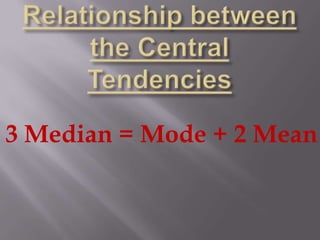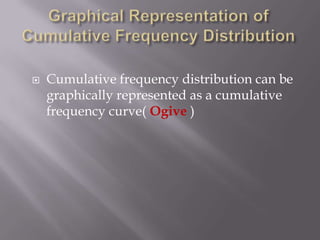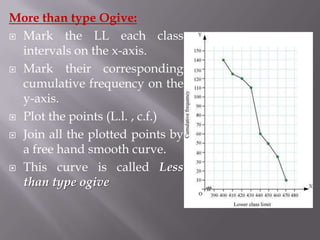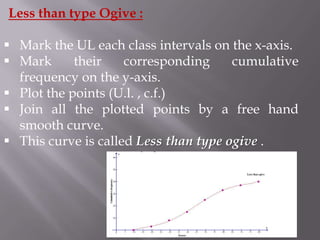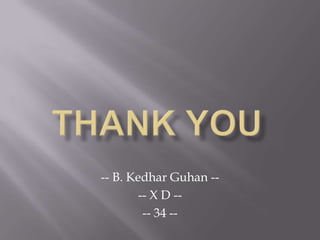Statistics
- 1. -- B. Kedhar Guhan -- -- X D -- -- 34 --
- 2. In this PPT, we would first recap what we had learnt in 9th.- • Histograms : SLIDE 3 • Frequency polygons: SLIDE 4 • Numerical representatives of ungrouped data: SLIDE 5
- 3. Then we sneak-a-peek on- Central Tendencies of a Grouped Data: SLIDE 7 Grouped Data : SLIDE 8 Mean of a grouped data: SLIDE 9 Direct Method: SLIDE 11 Assumed mean method: SLIDE 13 Step deviation Method: SLIDE 15 Mode: SLIDE 16 Concept of Cumulative Frequency: SLIDE 17 • Median: SLIDE 18 • Ogives : SLIDE 20
- 4. A Histogram displays a range of values of a variable that have been broken into groups or intervals. Histograms are useful if you are trying to graph a large set of quantitative data It is easier for us to analyse a data when it is represented as a histogram, rather than in other forms.
- 5. Midpoints of the interval of corresponding rectangle in a histogram are joined together by straight lines. It gives a polygon They serve the same purpose as histograms, but are especially helpful in comparing two or more sets of data.
- 6. 1. Arithmetic Mean: (or Average) • Sum of all observation divided by the Number of observation. • Let x1,x2,x3,x4 ….xn be obs.( thus there are „n‟ number of scores) Then Average = (x1+x2+x3+x4 ….+xn)/n
- 7. 2 Median: When the data is arranged in ascending or descending order, the middle observation is the MEDIAN of the data. If n is even, the median is the average of the n/2nd and (n/2+1/2 )nd observation. 3 Mode: It is the observation that has the highest frequency.
- 8. A grouped data is one which is represented in a tabular form with the observations (x) arranged in ascendingdescending order and respective frequencies( f ) given.
- 9. To obtain the mean, 1. First, multiply value of each observation(x) to its respective frequency( f ). 2. Add up all the obtained values(fx). 3. Divide the obtained sum by the total no. of observations. MEAN =
- 10. Lets find the mean of the given data. Marks 31 33 35 40 obtained (x) No. of 2 4 2 2 students (f ) Lets find the Σfx and Σf. x f fx Xi 31 Fi 2 FiXi 62 Xii 33 Fii 4 FiiXii 144 Xiii 35 Fiii 2 FiiiXiii 70 Xiv 40 Fiv 2 FivXiv 80 Σf = 2+2+2+4 = 10 Σfx = 62+144+70+80 = 356 So, Mean = Σfx = 356 =35.6 Σf 10
- 11. Often, we come across sets of data with class intervals, like: Class 10-25 25-40 40-55 55-70 70-85 85-100 Interval No. os 2 3 7 6 6 6 students To find the mean of such data , we need a class mark(mid-point), which would serve as the representative of the whole class. Class Mark = Upper Limit + Lower Limit 2 **This method of finding mean is known as DIRECT METHOD**
- 12. Lets find the class mark of the first class of the given table. Class Mark = Upper Limit(25) + Lower Limit(10) 2 = 35 = 17.5 2 Similarly, we can all the other Class Marks and derive this following table: C.I. No. of students(f ) C.M (x) fx Now, 10-25 2 17.5 35.0 mean = Σfx 25-40 3 32.5 97.5 40-55 7 47.5 332.5 Σf 55-70 6 32.5 375.0 = 1860 70-85 6 77.5 465.0 30 85-100 6 92.5 555.0 Total Σf=30 Σfx=1860.0 = 62
- 13. Another method of finding MEAN: 1. Choose one of the observation as the “Assumed Mean”. [select that xi which is at the centre of x1, x2,…, xn. 2. Then subtract a from each class mark x to obtain the respective d value (x-a). 3. Find the value of FnDn, where n is a particular class; F is the frequency; and D is the obtained value.
- 14. Mean of the data= mean of the deviations =
- 15. 1. Follow the first two steps as in Assumed Mean method. 2. Calculate u = xi-a h 3. Now, mean = x = a+h { }, Σ fu Σf Where h=size of the CI f=frequency of the modal class a= assumed mean
- 16. The class with the highest frequency is called the MODAL CLASS C.I. No. of C.M fx students(f ) (x) In this set of 10-25 2 17.5 35.0 data, the class 25-40 3 32.5 97.5 “40-55” is the 40-55 7 47.5 332.5 55-70 6 32.5 375.0 modal class as 70-85 6 77.5 465.0 it has the 85-100 6 92.5 555.0 highest Total Σf=30 Σfx=1860 frequency
- 17. It‟s the „running total‟ of frequencies. It‟s the frequency obtained by adding the of all the preceding classes. When the class is taken as less than [the Upper limit of the CI], the cumulative frequencies is said to be the less than type. When the class is taken as more than [the lower limit of the CI], the cumulative frequencies is said to be the more than type.
- 18. If n ( no. of classes) is odd, the median is {(n+1)/2}nd class. If n is even, then the median is the average of n/2nd and (n/2 + 1)th class. Median for a grouped data is given by Median = l{ n/2f- cf }h Where l= Lower Limit of the class n= no. of observations cf= cumulative frequency of the preceding class f= frequency h= class size
- 19. 3 Median = Mode + 2 Mean
- 20. Cumulative frequency distribution can be graphically represented as a cumulative frequency curve( Ogive )
- 21. More than type Ogive: Mark the LL each class intervals on the x-axis. Mark their corresponding cumulative frequency on the y-axis. Plot the points (L.l. , c.f.) Join all the plotted points by a free hand smooth curve. This curve is called Less than type ogive
- 22. Less than type Ogive : Mark the UL each class intervals on the x-axis. Mark their corresponding cumulative frequency on the y-axis. Plot the points (U.l. , c.f.) Join all the plotted points by a free hand smooth curve. This curve is called Less than type ogive .
- 23. METHOD 1 Locate n/2 on the y-axis. From here, draw a line parallel to x-axis, cutting an ogive ( less/more than type) at a point. From this point, drop a perpendicular to x-axis. The point of intersection of this perpendicular and the x-axis determines the median of the data.
- 24. METHOD 2: Draw Both the Ogives of the data. From the point of intersection of these Ogives, draw a perpendicular on the x-axis. The point of intersection of the perpendicular and the x-axis determines.
- 25. -- B. Kedhar Guhan -- -- X D -- -- 34 --



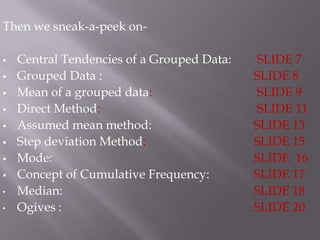


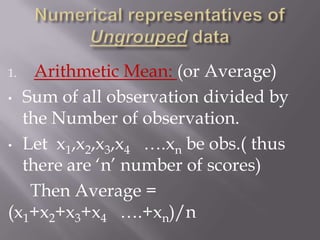






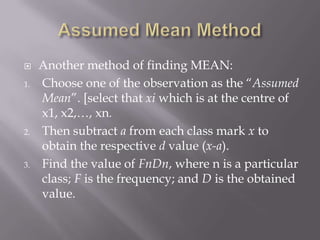



![ It‟s the „running total‟ of frequencies.
It‟s the frequency obtained by adding the of all
the preceding classes.
When the class is taken as less than [the Upper
limit of the CI], the cumulative frequencies is
said to be the less than type.
When the class is taken as more than [the lower
limit of the CI], the cumulative frequencies is
said to be the more than type.](https://izqule7twkl7vq3ljkxejyz-s-a2157.bj.tsgdht.cn/statistics-121027021122-phpapp02/85/Statistics-17-320.jpg)

